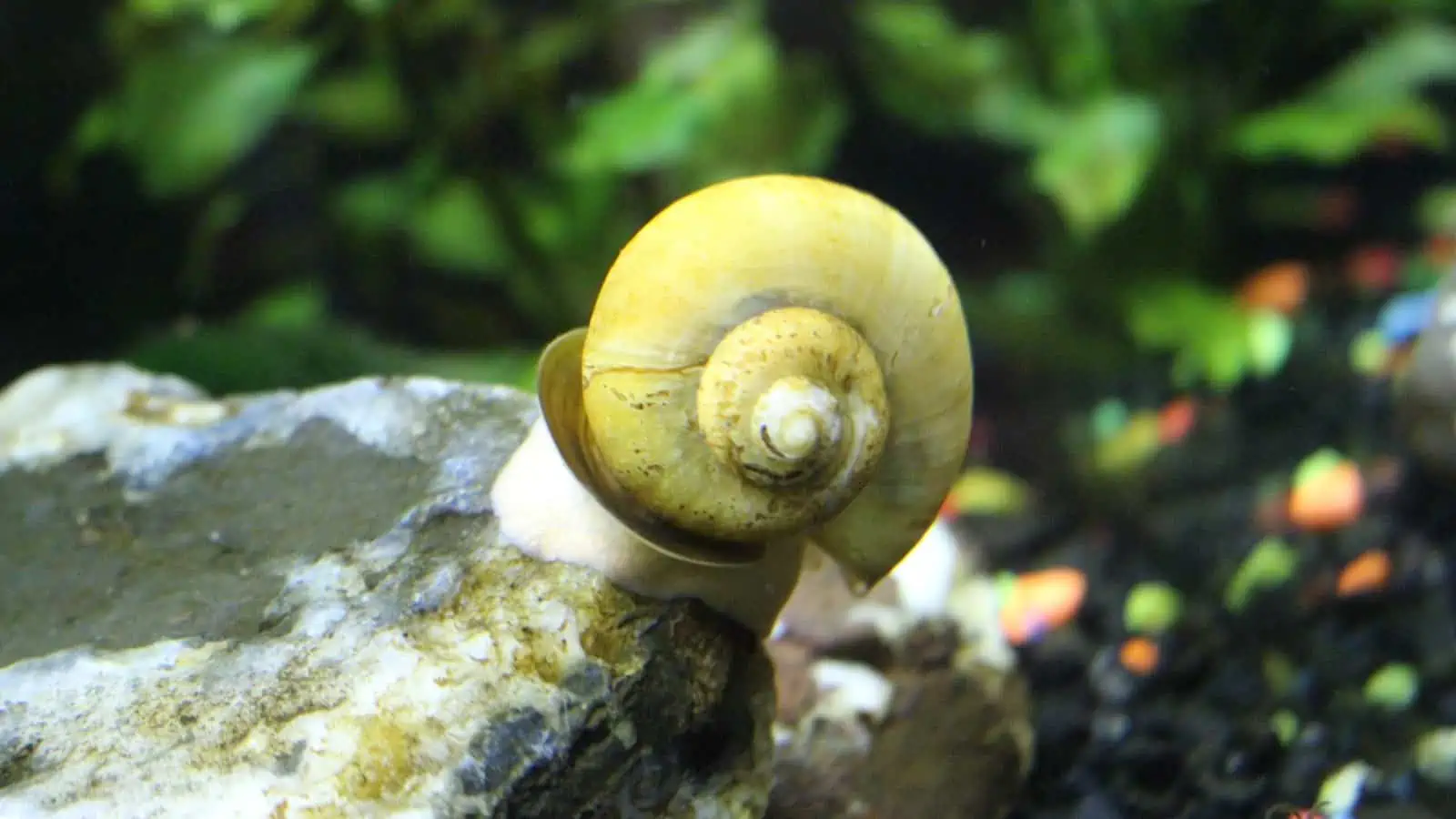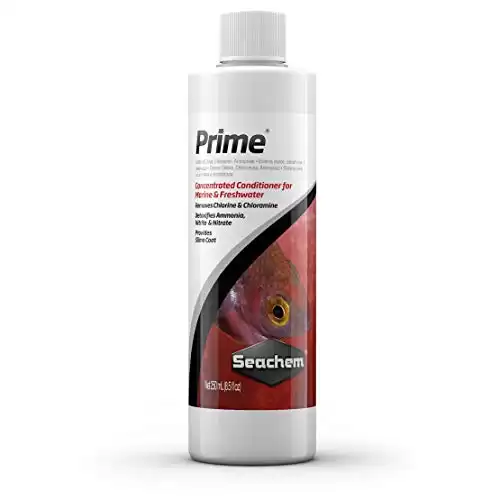Mystery snails are one of the most popular aquarium snails in the world, and one of the reasons is that they’re fairly easy to keep. That said, even the most robust mollusks can suffer from health issues now and then.
If your mystery snail is producing copious amounts of slime, it usually means that it’s sick, and may well need you to address the problem promptly for it to make a full recovery.
Why Is My Mystery Snails Producing Slime?
Like other slugs and snails, mystery snails produce a small amount of slime from a gland on their ‘foot’ to help them glide smoothly over various surfaces. You may even notice small traces of slime left behind after they’ve been feeding somewhere.
But healthy mystery snails should only produce very moderate amounts of slime. If you notice them producing larger quantities, it normally indicates that they’re stressed, and a serious health problem could be at hand.
Let’s take a look at some of the main causes of this ‘stress slime’ and how to rectify the situation to help your pet snails make a full recovery.
Mystery Snail Care at a Glance
| Mystery Snail Info | |
|---|---|
| Scientific Names | Pomacea Bridgesii or Pomacea Diffusa |
| Minimum Tank Size | 5-gallons |
| Water Temperature | 68°F – 82°F |
| Water pH | 7.0 – 8.0 |
| Water dGH | 7 – 18 |
| Water dKH | 3 -18 |
| Nitrate | Less than 20 ppm |
| Life span | 1 – 3 years |
10 Reasons Why Your Snail Might Be Producing Stress Slime
Incorrect Water Temperature
Mystery snails are fairly tolerant when it comes to water temperature. Accepting a temperature range anywhere from 68-82°F, they’re compatible with most freshwater fish, and can even be kept in an unheated tank in a warm room.
If temperatures fall outside this range, however, mystery snails can become stressed and may begin producing excess slime.
Thermal Shock
As well as being intolerant of water that’s too warm or too cold, mystery snails can also become unwell when the water temperature changes very suddenly.
While researching this topic, I came across several accounts of mystery snails becoming stressed or unwell after partial water changes caused a sudden temperature change.
Even a change of 3-4°F can be enough to cause thermal shock, which is why it’s so important to always refill your tank with treated water matching the temperature of your aquarium.
Incorrect Water Parameters
Another reason that mystery snails might start producing stress slime is when water parameters don’t match their requirements.
Like many other snails, mystery snails strongly prefer neutral to alkaline water to ensure a strong, healthy shell.
If your water chemistry becomes acidic (falls below pH 7), the shell can begin to dissolve and become thinner, making it more vulnerable to cracks, pits, and infections.
A water pH of between 7-8 and a water hardness of at least 10 dGH is ideal for mystery snails. If your water is softer or more acidic than this, you may need to add limestone, sustainably sourced crushed coral, or cuttlebone to make your water parameters more suitable.
Water Parameter Shock
As well as being in the right range for your snails, water parameters need to remain relatively stable.
If water chemistry changes very suddenly due to clumsy water changes, both fish and invertebrates can suffer from water parameter shock.
If your tap water is soft and acidic, you may need to add a small amount of bicarbonate of soda to it to make it harder and more alkaline before making large water changes.
Lack of Oxygen
You may have heard that mystery snails are so hardy that they can live in stagnant water without a filter. In reality, these mollusks much prefer fresh, clean water that’s well-oxygenated by a moderate to strong filter flow.
If they’re kept in a tank without sufficient oxygen levels, they may begin to hang out near the water’s surface, extending a specialized tube (known variously as a snorkel, hose, siphon, etc.) to breathe oxygen from above the water’s surface.
If you see your snail using its snorkel regularly, it may indicate low oxygen levels which should be remedied promptly. Adding an aquarium spray bar or lily pipe are great ways to increase surface agitation and thereby increase dissolved oxygen levels.
Ammonia Poisoning
Mystery snails that are kept without a reliable filter are also prone to an even more serious problem than oxygen deficiency – ammonia poisoning.
Just like fish, snails are intolerant to even low levels of ammonia or nitrites in the water and can easily die from ammonia or nitrite poisoning when placed in an uncycled aquarium.
As a primary indicator of ammonia or nitrite poisoning, snails may begin producing large amounts of ‘stress slime’. That’s one of the reasons that a water test should be the first course of action to take when you notice this symptom in your snails.
Chlorine or Chloramine Poisoning
An all too common and often fatal mistake that newbie aquarium owners make when filling their first fish tank is failing to treat their tap water.
Because chlorine, chloramine, and other chemicals that exist in municipal tap water are toxic to both fish and invertebrates, it’s essential to treat tap water before adding it to the tank.
Although snails are generally more tolerant to chlorine than fish, a sudden dose of chlorinated tap water may still cause them to become stressed and produce stress slime.
Remove chlorine either by leaving your tap water standing in a bucket for at least 24 hours or by adding a water treatment agent such as Seachem Prime.
- POWERFUL TREATMENT: Seachem Prime is a complete and concentrated conditioner for both freshwater and saltwater fish tanks, working hard to remove chlorine and chloramine.
- REMOVER: Seachem Prime immediately and permanently removes chlorine and chloramine, successfully allowing the bio filter to remove ammonia, nitrite, and nitrate while they are detoxified for 48 hours.
Copper Poisoning

Another element that’s even more toxic to snails and other invertebrates than chlorine is copper.
While freshwater snails can tolerate copper concentrations between 0.1 – 0.2 ppm, higher concentrations can be extremely dangerous to their health.
Some common fish medications contain copper to eradicate certain pathogens, but many aquarists apply them without realizing they’ll also poison their shrimp, crayfish, crabs, and snails.
In case you’re wondering about copper pipes – although many homes use copper piping for their water supply, the resulting concentrations of dissolved copper rarely reach dangerously high levels.
Incorrect Lighting Cycles
Another potential stressor that many new aquarists overlook is their aquarium lighting schedule.
Because most fish and invertebrates have evolved to receive approximately 12 hours of light followed by 12 hours of darkness, these same light cycles should be replicated in aquariums to help their biological clocks function normally.
If tank lights are left on all night or left off during the day, tank inhabitants may become extremely stressed and begin developing health problems.
The easiest way to ensure the correct day/night cycle in your fish tank is to install a timer switch – a simple and affordable piece of equipment that will turn lights on and off at the perfect time even when you’re away from home.
Insufficient Food
One final scenario when your snails might start producing stress slime is when they’re not receiving enough food.
Although mystery snails are versatile, opportunistic feeders that will gorge on algae, uneaten fish food, and even some types of detritus, a large population of them may eventually deplete the tank of food sources, leaving them hungry.
Because mystery snails breed so fast, they may sometimes overpopulate a tank, leaving resources like food and oxygen dangerously scarce.
If you’re becoming frustrated with mystery snails overbreeding, you could always consider nerite snails which don’t reproduce in freshwater.
One Last Tip – Remember a Tight Fitting Lid!
One of the most common complaints with mystery snails is their way of suddenly disappearing. Indeed this may be one of the ways that they earned their curious name!
Because mystery snails are especially prone to escaping from tanks when they’re feeling stressed, be sure to maintain an extremely tight-fitting lid without any gaps while you’re correcting any issues in their tank.
To learn more about caring for mystery snails, be sure to check out our in-depth care guide here.



